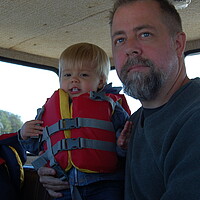Cause of Florida sinkhole tragedy: Human activity or revenge of the karst?
| ATLANTA
The news of a man being swallowed up by the earth as he slept in his Seffner, Fla., house seemed shocking precisely because it was so unusual: Only three men, two of them well drillers, are known to have ever died from a sudden sinkhole in Florida.
Yet the tragic series of events that began Thursday as a 30-foot hole swallowed Jeff Bush as he slept and continues Saturday as rescue crews tiptoe around an "extremely unstable" house also highlights just how geologically hazardous the Sunshine State is, and how human activities have likely increased the number of sinkholes – essentially geological plumbing breaks as the ceilings of carved-out limestone caverns buckle.
Within a mile of Mr. Bush's home, which apparently sits atop a 100-foot-wide cavern, are 16 verified sinkholes, compared to over 15,000 known sinkholes throughout the state.
Known as a "karst" landscape, Florida, which was once part of the seafloor, sits on a vast limestone bed cratered with caverns dug out over eons of tidal and chemical weathering. About 10 percent of the earth's landmass is karst, meaning land shaped by eroding bedrock.
"What feels capricious to those above is the toll of an active planet, one of those improbable collisions of a human timescale and a geological one," writes the Atlantic's Rebecca Rosen on Friday.
Thursday night's sinkhole drama did not fit the usual progression of dissolving karst, however. Sinkholes usually collapse in slow motion. Walls crack, strain, and complain as the earth begins to slowly give way under a house. In the vast majority of cases, residents have enough time to gather valuables and evacuate the premises.
"Losing a house to a sinkhole is very common, losing life is uncommon," says retired University of Florida geologist Tony Randazzo. "Most people will have some warning of the pending doom or catastrophic collapse. But there apparently were no warning signs of what happened at the Bush house. That would be very scary."
Witnesses said the house jarred suddenly, and then they heard yells from a bedroom. Jeff Bush's brother, Jeremy Bush, ran to the hole, jumped in and began digging for his brother.
"I heard my brother screaming," Bush told reporters. "So I ran back there and tried going inside his room."
A responding deputy told ABC News what he saw as he entered the panicked premises.
"When I turned in the bedroom the only thing that I saw was a hole, and the hole took the entire bedroom," Hillsborough County Sheriff's Deputy Douglas Duvall told a local ABC News affiliate. "You could see the bed frame, the dresser. Everything was sinking."
Mr. Duvall yelled to Jeremy Bush that the house was still collapsing and to get out of the hole. He reached in and pulled a stunned Mr. Bush out.
Changes in drainage due to construction or agricultural irrigation have been known to activate mass outbreaks of sinkholes, where dozens of sinkholes can suddenly appear next to drainage wells and farm fields. Drought followed by heavy rains can also instigate sinkholes as heavy, water-logged earth presses down on limestone caves suddenly devoid of buoyant water. The two previous deaths attributed to sinkholes both involved professional well drillers whose activities cracked the top of limestone caverns, causing collapse.
"Humans can [destabilize karst landscapes] by drawing down water tables or irrigate too much, increasing the weight of the mass of materials that sits on top of the void," says Jonathan Martin, a geologist at the University of Florida, in Gainesville. "Humans can modify the environment" enough to cause sinkholes.
It's not yet clear what caused the Seffner sinkhole, however, but geologists say the area, which is part of the heavily populated I-4 corridor that crosses Florida's midriff from Tampa to Daytona, is particularly prone to sinkhole collapses.
Sinkholes affect so many properties in Florida that the legislature in 2011 changed the law to make it harder to claim sinkhole damages.
"Over the years the [sinkhole] costs to insurance companies have been increasing at an extraordinary rate, because the legislature prevented companies from charging rates in line with the risk," says Mr. Randazzo. "It finally reached the point where the insurance companies won the day and got the legislature to change the law, significantly weakening the sinkhole protections in the state of Florida."





